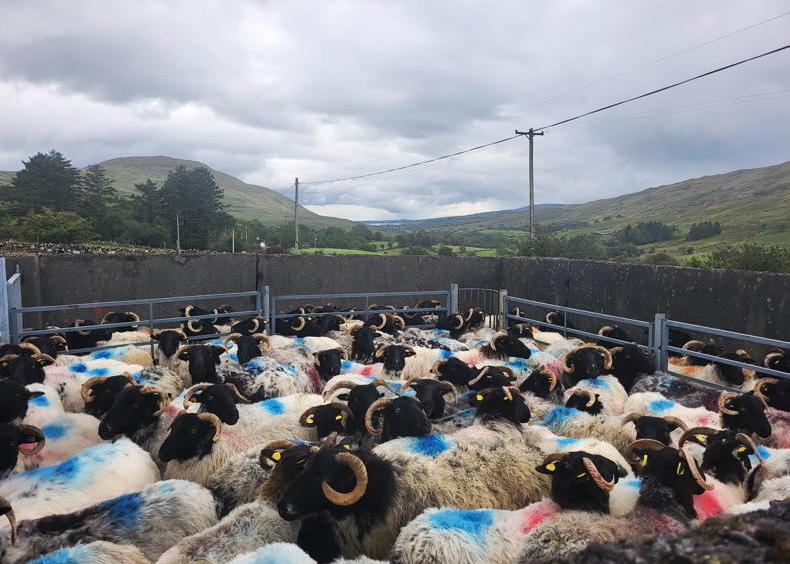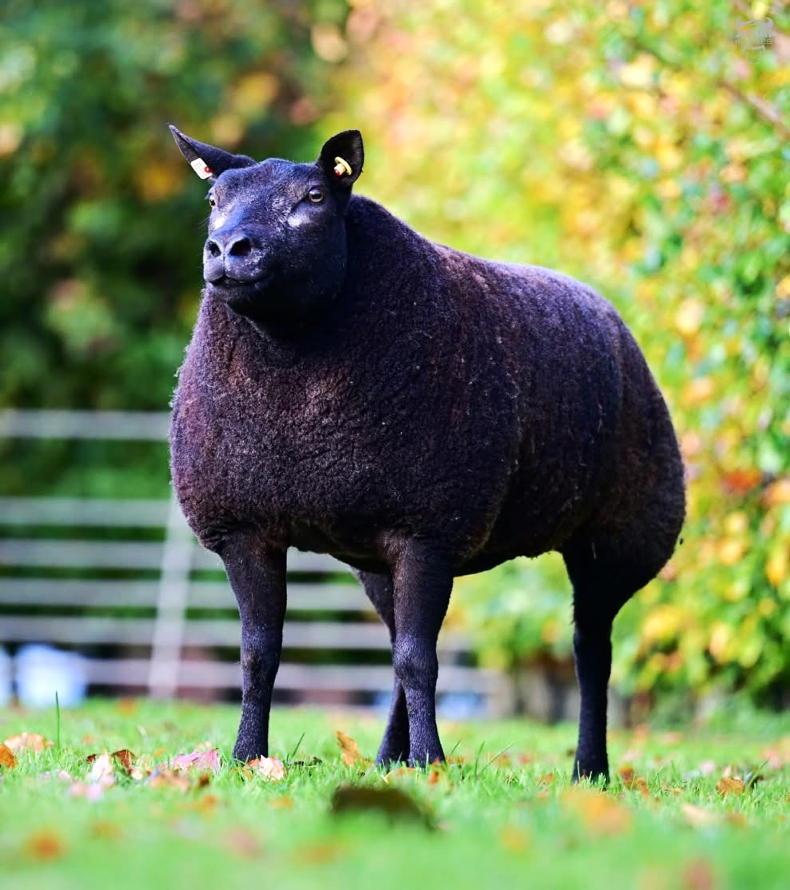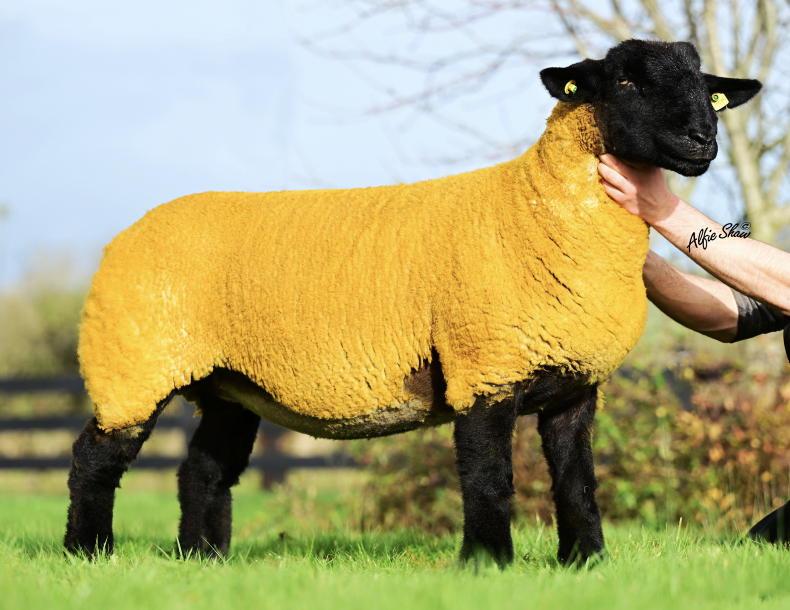The profile of sheep flocks in Ireland with upwards of 40% of flocks with less than 50 sheep and over 65% of flocks with 100 sheep gives rise to many farmers opting to purchase replacements.
A higher percentage of larger-scale farms breed their own replacements to maintain a closed flock, but some still prefer to source replacements with desired maternal traits that they can’t readily breed themselves. Mules and Suffolk X Cheviot crosses are good examples of this.
There is an expectation that hogget supplies could be tighter this year following the record prices paid and anecdotal reports of significant numbers of ewe hoggets being drafted for slaughter.
It is still early days to gauge just how tight supplies will be.
A number of mart managers and breeding group co-ordinators report that they expect sale entries to be back anywhere from 15% to 20%.
Lower demand
There is also the question of demand will be lower this season, with reports of farmers cutting back in ewe numbers and hoggets possibly representing a higher cost.
The latter point of hogget cost will be helped by more life entering cull ewe markets.
There is always merit in reviewing different aspects of your farming system, including your flock’s replacement policy. The greatest control of your flock’s genetics and health status is, in theory, achieved from a closed flock policy.
However, purchasing replacements does provide an opportunity to dip into a different gene pool and can be successfully implemented provided a robust quarantine protocol is in place.
Cost is also another element to consider. Tables 1, 2 and 3 provide a blueprint for reviewing the financial costs of your replacement policy. Looking at Table 1 first, the option of purchasing hoggets is possibly the most straightforward.
A health charge of €15.50 is added in as a cost which may seem excessive to many. The costs of note here are vaccination against enzootic abortion, toxoplasmosis, clostridial disease, two worm and two fluke treatments, lameness control and external parasite treatment. Some of these costs may be avoided where the health policy of the flock you are purchasing from is known.
The cost of a hogget listed as €200 may be low to some, but this could also be said of the cull ewe value. It is likely that costs for large-framed ewe hoggets will translate to higher returns for cull ewes, so even if the purchase price is increased there may be little difference in the financial implications.
As such, it is important that farmers use the table as a blueprint and use their own figures.
Dry ewe lambs
The option listed in Table 2 looks at purchasing ewe lambs and running them dry over the first winter.
This again is an option being looked at by some farmers to reduce the workload at lambing while still keeping numbers at a relatively static level. Some farmers have added a dry hogget enterprise onto their system to replace lower ewe numbers.
The review exercise can be carried out where retaining your own ewe lambs with their equivalent value used as their purchase price. The veterinary cost remains relatively high with vaccinations again accounting for the highest percentage of costs.
A grass and silage cost is included and it is accepted that ewe lambs are well grown and do not require concentrate supplementation.
The net replacement cost in this scenario is lower than purchasing hoggets, but account needs to be taken of the fact that ewe lambs are not contributing to output for a year.
Table 3 looks at the option of breeding ewe lambs as opposed to running them dry.
The analysis is based on high levels of efficiency – it is assumed that upwards of 80% of ewe lambs go in lamb and scan a litter size of approximately 1.2 lambs per yearling hogget mated and wean at least one lamb per hogget lambed. The value of progeny is taken at €90 per head.
Meal feeding
Meal feeding is factored into the system to allow concentrates to be introduced earlier in late pregnancy and also fed for a four-to-five week period in early lactation.
A cost is also factored into the equation for creep feed offered to lambs to help sustain performance and reduce pressure on lactating hoggets.
The other cost category factors in higher costs for straw bedding with ewe lambs housed for longer and a contribution towards equipment such as creep feeders for example.
A higher veterinary cost is also assumed to account for the possibility of veterinary assistance and aspects such as blowfly treatment in lambs, faecal egg counts etc.
Breeding yearling hoggets offers faster incorporation of genetics into a flock and also provides the potential to increase lifetime performance by 10%. While it represents the lowest cost of incorporating replacements, the system requires precise management and possibly access to lambing facilities for a longer period of time.
Farm circumstances
The financial budgets should be used as a guide. They are only as good as the information used to formulate them and therefore realistic costs should be used for your own farm.
It is important not to compare systems on price alone as the policy needs to take into account how it dovetails with the farm’s circumstances.

Better farmer Peadar Kearney and Joanne Martin, Tallanstown moving ewes on lambs to fresh pasture this week.
- Reviewing your farm’s replacement policy from time-to-time is good practice to see that it is still the best fit for the farm.
- Where purchasing replacements, one of the most critical aspects is implementing a robust quarantine procedure.
- Breeding yearling hoggets offers the potential for the lowest replacement cost but possibly requires the greatest level of specialisation.
The profile of sheep flocks in Ireland with upwards of 40% of flocks with less than 50 sheep and over 65% of flocks with 100 sheep gives rise to many farmers opting to purchase replacements.
A higher percentage of larger-scale farms breed their own replacements to maintain a closed flock, but some still prefer to source replacements with desired maternal traits that they can’t readily breed themselves. Mules and Suffolk X Cheviot crosses are good examples of this.
There is an expectation that hogget supplies could be tighter this year following the record prices paid and anecdotal reports of significant numbers of ewe hoggets being drafted for slaughter.
It is still early days to gauge just how tight supplies will be.
A number of mart managers and breeding group co-ordinators report that they expect sale entries to be back anywhere from 15% to 20%.
Lower demand
There is also the question of demand will be lower this season, with reports of farmers cutting back in ewe numbers and hoggets possibly representing a higher cost.
The latter point of hogget cost will be helped by more life entering cull ewe markets.
There is always merit in reviewing different aspects of your farming system, including your flock’s replacement policy. The greatest control of your flock’s genetics and health status is, in theory, achieved from a closed flock policy.
However, purchasing replacements does provide an opportunity to dip into a different gene pool and can be successfully implemented provided a robust quarantine protocol is in place.
Cost is also another element to consider. Tables 1, 2 and 3 provide a blueprint for reviewing the financial costs of your replacement policy. Looking at Table 1 first, the option of purchasing hoggets is possibly the most straightforward.
A health charge of €15.50 is added in as a cost which may seem excessive to many. The costs of note here are vaccination against enzootic abortion, toxoplasmosis, clostridial disease, two worm and two fluke treatments, lameness control and external parasite treatment. Some of these costs may be avoided where the health policy of the flock you are purchasing from is known.
The cost of a hogget listed as €200 may be low to some, but this could also be said of the cull ewe value. It is likely that costs for large-framed ewe hoggets will translate to higher returns for cull ewes, so even if the purchase price is increased there may be little difference in the financial implications.
As such, it is important that farmers use the table as a blueprint and use their own figures.
Dry ewe lambs
The option listed in Table 2 looks at purchasing ewe lambs and running them dry over the first winter.
This again is an option being looked at by some farmers to reduce the workload at lambing while still keeping numbers at a relatively static level. Some farmers have added a dry hogget enterprise onto their system to replace lower ewe numbers.
The review exercise can be carried out where retaining your own ewe lambs with their equivalent value used as their purchase price. The veterinary cost remains relatively high with vaccinations again accounting for the highest percentage of costs.
A grass and silage cost is included and it is accepted that ewe lambs are well grown and do not require concentrate supplementation.
The net replacement cost in this scenario is lower than purchasing hoggets, but account needs to be taken of the fact that ewe lambs are not contributing to output for a year.
Table 3 looks at the option of breeding ewe lambs as opposed to running them dry.
The analysis is based on high levels of efficiency – it is assumed that upwards of 80% of ewe lambs go in lamb and scan a litter size of approximately 1.2 lambs per yearling hogget mated and wean at least one lamb per hogget lambed. The value of progeny is taken at €90 per head.
Meal feeding
Meal feeding is factored into the system to allow concentrates to be introduced earlier in late pregnancy and also fed for a four-to-five week period in early lactation.
A cost is also factored into the equation for creep feed offered to lambs to help sustain performance and reduce pressure on lactating hoggets.
The other cost category factors in higher costs for straw bedding with ewe lambs housed for longer and a contribution towards equipment such as creep feeders for example.
A higher veterinary cost is also assumed to account for the possibility of veterinary assistance and aspects such as blowfly treatment in lambs, faecal egg counts etc.
Breeding yearling hoggets offers faster incorporation of genetics into a flock and also provides the potential to increase lifetime performance by 10%. While it represents the lowest cost of incorporating replacements, the system requires precise management and possibly access to lambing facilities for a longer period of time.
Farm circumstances
The financial budgets should be used as a guide. They are only as good as the information used to formulate them and therefore realistic costs should be used for your own farm.
It is important not to compare systems on price alone as the policy needs to take into account how it dovetails with the farm’s circumstances.

Better farmer Peadar Kearney and Joanne Martin, Tallanstown moving ewes on lambs to fresh pasture this week.
- Reviewing your farm’s replacement policy from time-to-time is good practice to see that it is still the best fit for the farm.
- Where purchasing replacements, one of the most critical aspects is implementing a robust quarantine procedure.
- Breeding yearling hoggets offers the potential for the lowest replacement cost but possibly requires the greatest level of specialisation.











SHARING OPTIONS